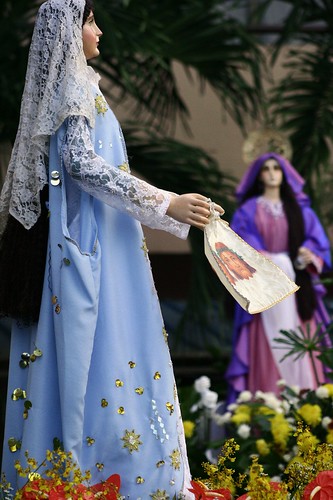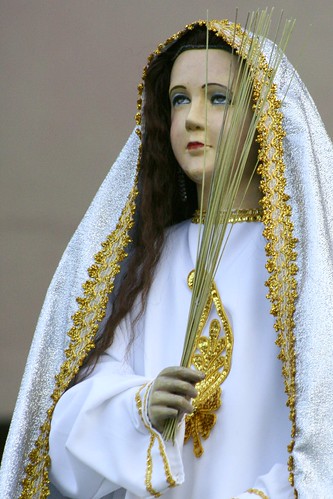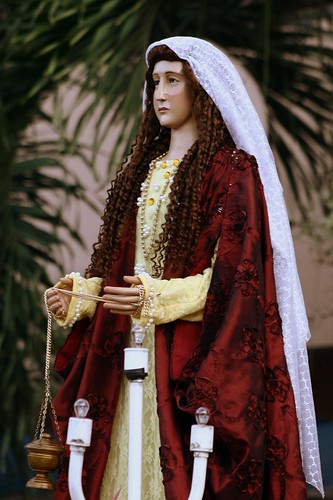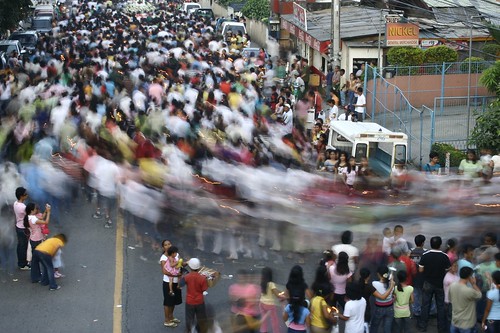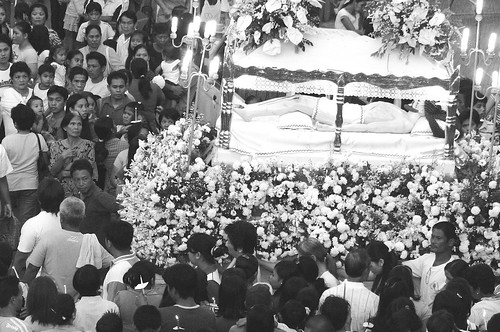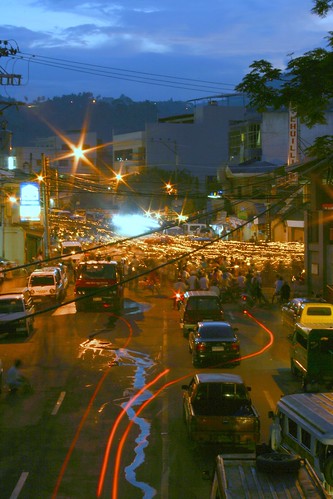Viernes Santo 2008, part 2
Tableaux
Aside from singular standing icons, there were a few tableaux paraded during Good Friday at Talamban. These are biblical scenes which consist of 2 or more images. There could be more than three tableaux but it was difficult to cover everything in the little time I had.
First, there was the Pieta which is a relatively new addition to the Talamban lineup and owned by a local councilor Nestor Archival. Unquestionably, its design was derived from Michelangelo’s marble masterpiece. I must admit that in the photograph below, I was more interested in presenting the colorfully garbed lay ministers playing the “Apostles” during the Good Friday proceedings than the Pieta or the Santo Entierro in the background.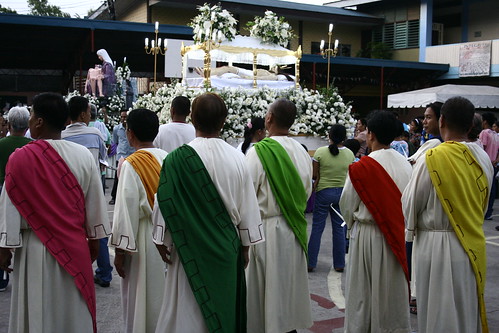
Canon EOS 350D Digital, 1/500s, f/5.0, 190mm, ISO 800, +2/3EV
the Pieta tableau and the Santo Entierro, as framed by the lay ministers dressing up as the Apostles during the Good Friday procession, Talamban, Cebu City
phototip: Bring life to procession shots by framing them with people.
I was only able to shoot one other tableau, which I think is The Third Last Words. Conveniently parked in front of the school gate, the Crucifixion features the Crucified Christ, the Blessed Virgin Mary, Mary Magdalene and St. John the Evangelist. I took a few frames and below are 3 versions.
The first photo was an attempt to isolate the Mater Dolorosa (Grieving Mother) and the Crucified Christ. I tried to eliminate St. John from the frame but not completely so as the halo could still be seen at the right border of the frame. However, I like how the late afternoon sky came out clean and blue.![Crucifixion [2]](http://farm3.static.flickr.com/2091/2362930763_d8808ccbd5.jpg)
Canon EOS 350D Digital, 1/1000s, f/18, 50mm, ISO 100
the Crucifixion tableau, Good Friday procession, Talamban, Cebu City
The next picture incorporated Mary Magdalene in the frame. I tried several angles but this time, the background proved to be the distraction. The windows of the house across the school stick out sorely.![Crucifixion [3]](http://farm3.static.flickr.com/2324/2362932017_52f02aaf02.jpg)
Canon EOS 350D Digital, 1/640s, f5.0, 95mm, ISO 400, +1/3 EV
the Crucifixion tableau, Good Friday procession, Talamban, Cebu City
I like the last shot best. It was not taken near the image but was shot some 20 meters away, on higher ground (the church is on a hill overlooking the parish school). There were however, too many streamers and painted murals on the walls. Given no alternative, I tried to present them as a religious context to the scene. I also believe that the high angle managed to illustrate the excitement of the dense crowd just when the procession was about to start.
Canon EOS 350D Digital, 1/500s, f/5.6, 240mm, ISO 800, +2/3EV
the Crucifixion tableau, Good Friday procession, Talamban, Cebu City
Santo Entierro
Ask any Filipino what the climax of the Good Friday procession is and you’ll get a unanimous answer: the Santo Entierro (the Holy Burial or Haya in Cebuano). The parade rightfully reserves a central role to the Santo Entierro as a penitential commemoration of the Jesus’ sacrifice in Calvary.
Talamban’s Santo Entierro, I’ve been told, is owned by the family of the late Vicente Leyson, a former barangay captain, and is as old as the church that was established in the 1960s. As called for by custom, the Santo Entierro is placed in a hearse adorned only with white flowers, linen and lamps although the wooden carroza is painted in gold, which came out remarkably photogenic in pictures.
Canon EOS 350D Digital, 1/125s, f5.6, 40mm, ISO 800, +1/3 EV
the Santo Entierro just before the start of the Good Friday procession, the San Isidro Parish Church, Talamban, Cebu City, the Philippines
phototip: The classical golden section is an effective composition.
Canon EOS 350D Digital, 1/320s, f5.0, 40mm, ISO 800, +1/3 EV
the Santo Entierro just before the start of the Good Friday procession, the San Isidro Parish Church, Talamban, Cebu City, the Philippines
phototip: Photographing the photographer is interesting when the subject is a woman of cloth!
the Veneration
The procession began a little past 5:30 P.M. Following a route that was around 4 kilometers long, the procession only started to file back an hour later. Because of the thick crowd, it took another 15 minutes for all of the carrozas to get back in the school grounds. As expected, upon arrival at the parish school yard, there was a rumble as people elbowed each other to get the flowers adorning the carts, especially that of the Santo Entierro. Belief is that they are miraculous having been blessed in the act of the procession. These flowers are often incorporated in cure-all elixirs called in the vernacular as lana (oil) or haplas (salve). I pity the carroza marshalls for they cannot never really save the flowers but only safeguard the icon from vandalism or damage.
Only the Santo Entierro gets the honor to be ushered inside the Church. It was laid in front of the altar. Automatically, people flanked the image at three sides and the lay ministers had to move in quickly to form queues and maintain order.
Photographing the scenes of veneration was difficult as the jostling madness could not give me any clear shot. Fortunately, I saw that the stairwell leading to the choir loft was not locked. Nobody really minded me sneaking up and settling my tripod. The view from above was perfect. My telephoto lens is not really that powerful nor sharp but it is serviceable on occasions like this one.
The weakness of the 75-300mm 1:4-5.6 II USM lens is nevertheless obvious. Grain can be an issue especially with a crop as severe as the one below. The flickering shadows are actually the moving lines of the worshippers who kissed the image in a span of 20 seconds.![Haya [2]](http://farm3.static.flickr.com/2355/2363780170_e0313006ac.jpg)
Canon EOS 350D Digital, 20s, f/29, 230mm, ISO 100, -1/3 EV
the Santo Entierro, during Good Friday, the San Isidro Parish Church, Talamban, Cebu City, the Philippines
phototip: I chose a narrow aperture to achieve an exposure of 20 seconds. This allows me to make the worshippers filing to kiss the Holy Body “disappear” into indistinct but ghostly shadows.
Getting a clean shot of the chaos was a challenge. I had to time a shot wherein the Santo Entierro would not be totally covered by people during the exposure. I also composed a frame that juxtaposed the snaking queues against the others worshippers who chose to say their petitions in silence on the pews. Below is one version in full saturated colors.![veneracion [2]](http://farm4.static.flickr.com/3111/2363781186_ab62dd6d74.jpg)
Canon EOS 350D Digital, 25s, f/22, 49mm, ISO 100, -1/3 EV
the queue to kiss the Santo Entierro, San Isidro Parish Church, Talamban, Cebu City, the Philippines
phototip: Time the shot to ensure that the photo gets a clear view of the subject, the Santo Entierro.
The photo below is the actually the same as the one above, only that I cropped the scene closer to the Santo Entierro. The conversion to black and white allows clearer isolation the subject, as the eye is ultimately led towards the subject of veneration.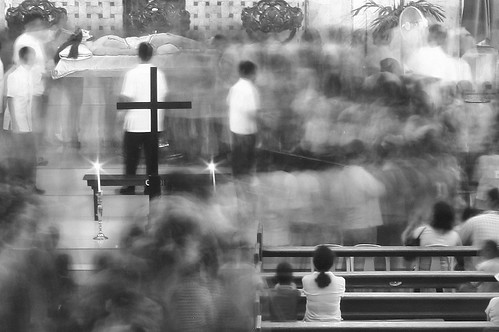
Canon EOS 350D Digital, 25s, f/22, 49mm, ISO 100, -1/3 EV
a closer crop of the queue to kiss the Santo Entierro, San Isidro Parish Church, Talamban, Cebu City, the Philippines
When I left the church that night, I realized that not like in the past, I was not really able to walk through the procession. Playing the photographer prevented me so. But documentating is not just spectating. I left with a renewed sense of belief that recording acts of faith is an active affirmation of my own.






